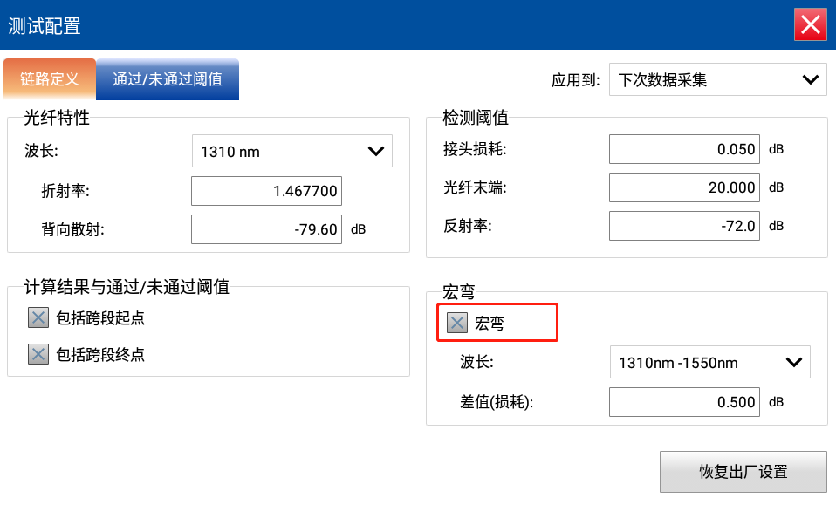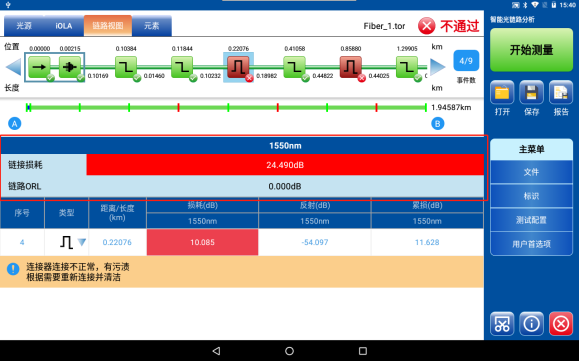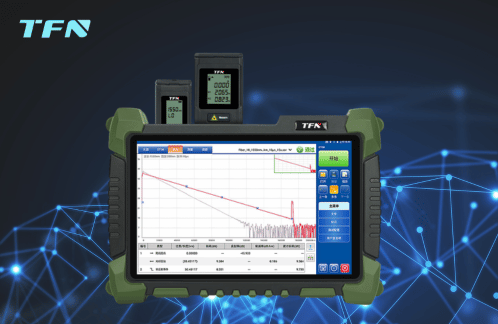How does an optical time domain reflectometer perform macrobend analysis?
An optical time domain reflectometer (OTDR) is a device used to detect and analyze the characteristics of optical fiber channels. Its working principle is based on optical time domain reflectometry technology. By sending optical pulses and measuring the reflected optical signals, a reflection curve diagram of the optical fiber is generated to identify various events and undesirable phenomena in the optical fiber, such as breakpoints, joint attenuation, macrobends, and microbends.

When performing macrobend analysis, the difference between microbends and macrobends lies mainly in the scale of the bend and the degree of loss caused. Macrobend refers to the bending of an optical fiber within a large radius, which will cause abnormal attenuation of signal power during optical fiber transmission. The following are the general steps for macrobend analysis using TFN RM7 OTDR:
1. Preparation
- Equipment preparation: Make sure the OTDR is in normal working condition and select the appropriate test wavelength (usually 1310nm and 1550nm).
- Fiber connection: Connect the optical fiber to be tested to the OTDR correctly to ensure good connection quality and reduce the impact of connection loss.
2. Set Parameters
The TFN RM7 OTDR measures the event loss values of a given wavelength (e.g. 1310nm) and another wavelength (e.g. 1550nm) at the same location, and then compares the two loss values to locate macrobends.
When comparing the two loss values, the device will confirm a macrobend if the following conditions occur:
The loss of the longer wavelength of the two loss values is greater.
The difference between the two loss values is greater than the specified loss difference. The default loss difference is 0.5dB (suitable for most optical fibers).
You can also change the difference according to actual conditions.
Note: Macrobends cannot be used for single-mode single-wavelength, but can be used for single mode multi-wavelength. The macrobend detection function is only applicable to single mode wavelengths. Macrobend detection cannot be performed on filtered wavelengths or single-wavelength ports.
3. Data Acquisition
- Start the measurement, send optical pulses, and record the reflected signal in the optical fiber.
- The OTDR generates a fiber reflection curve (a curve of optical power changing with distance).
4. Data Analysis
- Observe the graph: In the reflection graph, macrobends are usually manifested as a sudden increase in reflection loss in a local area, which is manifested as a "step-like" or a local sharp drop.
- Compare wavelengths: Observe the difference in fiber loss at different wavelengths. Macrobend loss is more sensitive to the 1550 nm wavelength. If a sudden change that exceeds the normal loss occurs at this wavelength, it may be caused by macrobends.

5. Positioning and Quantification
- Event positioning: Using the built-in event graph analysis function of the OTDR software, the specific location of the macrobend can be automatically or manually located. The macrobend event on the TFN RM7 OTDR event graph is displayed as .
- Loss measurement: Measure the power change of the fiber before and after the macrobend to quantify the specific loss value caused by the macrobend.
- The TFN RM7 OTDR can also enter the fiber loss difference in the Intelligent Optical Link Analysis (IOLA) function, and the application can perform a pass/fail test to determine the status of the measurement result.
6. Treatment Suggestions
- Bend improvement: According to the positioning results, physically alleviate or eliminate the fiber bending problem, and improve the standardization and neatness of fiber laying.
- Maintenance records: Record the details of macrobends, including location, loss value and rectification measures, as part of the maintenance documentation.

By using OTDR to analyze fiber macrobends, it is helpful to timely discover problems in the fiber link and perform effective maintenance and processing, thereby improving the reliability and performance of the fiber communication system.
TFN RM7 OTDR is a high-performance multi-function test platform launched for high-precision fiber testing. It is widely used in the installation and maintenance of network systems including core networks, metropolitan area networks and access networks. RM7 is equipped with optical power meter, VFL, fiber end face detection, optical loss test, fault location, intelligent optical link analysis (IOLA), laser ranging, and network testing functions. Its optical power meter and VFL red light module, laser ranging module can be plugged in and used independently and integrated with the system.
RM7 OTDR can provide a view of the internal status of the fiber, accurately analyze and diagnose problems in the fiber link, meet a variety of testing requirements, and is a highly cost-effective fiber testing instrument.

If you are interested in TFN RM7 series optical time domain reflectometer, please contact TFN sales team:
Email: info@tfngj.com
WhatsApp: +86-18765219251
Facebook: https://www.facebook.com/tfnfate/
